Text
An Exploration of Tattoo Culture in the Gilded River

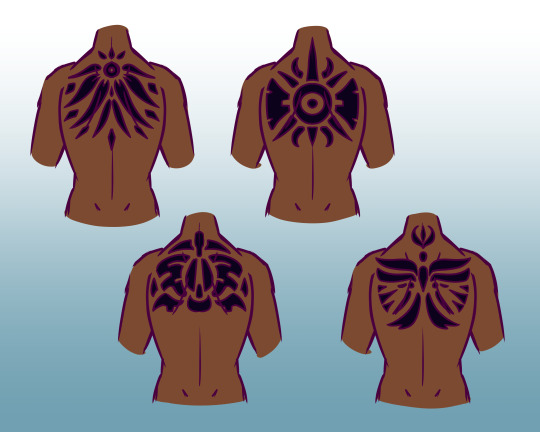


-By Professor Matakare of Anthropology, documented in Traveling and Wandering - A Study of Peoples and Cultures Across the Globe
Coming from a culture that does not partake in tattoos, it was fascinating to examine the rich tattoo culture of the Gilded River. There are rules, artisans, and histories behind every permanent mark on a person’s skin. Equal parts fascinating and wonderful, learning along side my dear Masha as he discovered this aspect of his own culture, embracing it with his full heart.
The first tattoo that many receive is on the upper back. It’s also often the largest individual design a person is likely to receive. It is the family tattoo, a family crest if that makes it easier to understand. It’s unique to each family, varying in complexity depending on how old or important the family is. A child who reaches the age of 16 receives the tattoo, the same one on their father’s back. If there is need for a new family design, for whatever reason, the temples are consulted. They either opt to adopt an extinct family’s design, or work to form an entirely new one.
The next is one on their arms. When a newly entered adult begins a trade, they start as an apprentice. When the apprenticeship is complete, they receive their first skill tattoo, starting on the upper half of their dominant arm, leaving room to add more as they grow in skill or change trade.
As they grow older, with some luck the young man or woman might gain a mark on their lower back. This is a marriage tattoo, often a modified version of their partner’s family design. When Masha and I got married, since I was a foreigner without a family crest in this culture, he consulted a temple worker to create a design to put on his back, in my honor. I also partook to add a mark to my own back, much to the surprise of anyone who happens to spot me in a bathhouse back home.
As people grow and age, they gain experiences and triumphs under their belt. Special, noteworthy achievements are memorialized on the chest for all to see. There are many designs, too many to list here, but the most common one I’ve seen is the mark of parenthood. I can’t imagine it is easy rearing children in the desert, so I understand their celebration. When their oldest children reach their coming of age, both parents receive their mark. Others I’ve seen denote brave warriors who fought with valor in battle, or inspirational leaders who navigated a crisis. Masha actually received a rather rare mark on his chest, one of the Globe Trotter. I suppose him following me on this adventure really paid off in that regard. He also tracked down a community of his people when we returned home, and added his own mark of parenthood when our girls came of age. The tattoo artisan we spoke with also decided to make a mark for me. He’s seen the scars on my chest, and decided they were their own mark of valor when I explained what they were. He decorated them “In honor of your discover of self.” I am not ashamed to admit I cried.
I think I might’ve gotten sidetracked, so I will add a few final thoughts here. There are two other noteworthy locations for tattoos, the head and stomach, and the legs. The head and stomach are grouped together, as sacred places on the body, containing the mind and spirit respectively. Only holy men are to tattoo these regions, with the Sun King having nearly his whole face covered from what I could see and gather. Finally, the legs are for personalized designs. Aesthetic markings, memorials, celebrations, those are meant for the thighs.
As I had said before, there is a rich culture of designs and histories here, more so than this short passage could give justice. I encourage anyone curious to seek out a community of the Gilded Rivers, there’s often neighborhoods where they congregate, and ask about it yourself. Consider yourself honored if they choose to share in this tradition with you.
-------------------------
Author's note:
Hi! I'm back, at least for now. I have the ADHD brain so I will have bursts of activity and periods of rest for this blog. I got inspired again recently, so here's a new post for Worldbuilding Wednesday!
I have a comic to answer an ask that'll start cooking after October, since I'm doing a Halloween drawing challenge.
#worldbuilding#worldbuilding wednesday#fantasy worldbuilding#ask blog#send me asks#ask box open#my art#digital art#worldbuilding ask blog#fantasy#fantasy lore#lore dump
1 note
·
View note
Text
The United Islands - Getting Dressed
Step 1: Pants
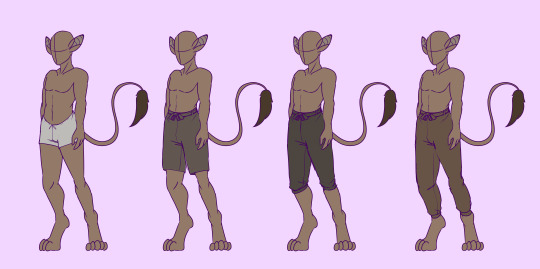

So, pants are mostly woven cotton, wool, or linen (depending on climate). There's a belt that's sewn into the back, that's fed through loops at the side, and then tied secure at the middle of the stomach. Pants can be worn by anyone, but skirts are pretty much only by either women or the nomadic peoples in the desert. There isn't any wiring in the "bras", its more to keep the breasts secured to the chest for working women. Nursing mothers, older women, and those who work more sedentary jobs often don't wear them at all.
Step 2: Tunic


Tunics are unisex, mostly flax, cotton or wool, and is composed of one continuous piece of cloth that wraps around the back and pulled over the arms like one would put on a jacket or vest. They're held closed by a metal clasp (or several if the garment is long). Tunis come in all kinds of configurations, shapes, colors, and lengths. The most standard is often sleeveless, and goes down to a few inches past the bellybutton. There's often decorative stitching (usually yellow/orange or gold colored) along the sleeve seam, or the edges of the garment. Fancier tunics are often dyed or embroidered with flower or vine patterns using flax thread. Base colors most often include greens, yellows, oranges, reddish-browns, and cream.
Step 3: Belt

To add shape to the tunic, and further secure it, the outfit is most often completed with a wool or cotton belt. There's four usual styles for belts; the single band side knot, the double banded side knot, the back knot, and the front fold over.
And, there you have it! How to get dressed in the United Islands.
A few additional notes and disclaimers:
These outfits are assuming you're an average joe. What the very poor or very rich wear, what's considered formal or fancy, and the differences between hot and cold weather gear are probably going to be posts all on their own. But this is what your average citizen would be wearing on a day to day basis.
All of these different shapes can come in all of the colors displayed here. Some colors are only available to the aristocracy, but again, that'll be explored in another post.
Jewelry, accessories, and hairstyles will all probably be addressed in their own post as well!
#worldbuilding wednesday#fantasy worldbuilding#worldbuilding#ask blog#send me asks#ask box open#my art#digital art#worldbuilding ask blog#worldbuilding clothing#clothing design#fantasy clothing
1 note
·
View note
Text

The King Must Die - An Account of the Succession Practices of the Twin Kingdoms
-By Professor Matakare of Anthropology, documented in Traveling and Wandering - A Study of Peoples and Cultures Across the Globe
"When the boy entered the tent, he was not dressed in the garb of a future king. He was covered in muck, mud, freezing ice, and blood. Whether the blood was from animals or his fellow competitors, I do not know, nor do I wish to know. His box was perfectly in tact. His skin and hair were dark as coal, I presume his origin was that from the lowlands.
He seemed startled by my presence, and nearly drew a knife on me before the king raised his hand to stop him. The monarch had a solemn but resigned look on his face. He turned to me, and nodded.
"Thank you for listening to my story, scholar. While the moons can read it through my hair, I thank you for recounting it till the end for us who must breathe. I wish you safe travels my friend, for you and your companion."
The boy kneels before the king, sitting in much the same manner as him. His face was tired, nervous, but as resigned as the king.
The box was finally opened, by one of the many attending guards. There were jewels, many precious things. They are meant to the boy's family. The only prize for the boy was hidden away in a small leather satchel. The dried flowers and leaves within were poured into a prepared tea pot, one meant to pour two drinks.
The king was methodical when he poured the tea. Calm. Eerily so, even as a guard maneuvered behind him.
In one cup, for the boy, was a fancy brew of fragrant, pungent flowers and herbs. In the other, for the dead man that still breathed, is a tainted concoction. It smells so, heavy with the bitterness of poisons.
They picked up their cups at the same time.
"Are you ready to inherit the spirit of the mountains? Of the mother, and her watchful father, under the gaze of her heavenly suitors?" the king had asked the boy.
"I am, your Grace."
"The mountain has deemed you worthy, and your character rings true. Take my breath, and rule with honor. And know your breath will be taken when the vessel would poison the breath with rot."
The two bowed to each other and drank from their cups. The guards started to rhythmically bang their staffs against their shields, as the king's breathing weakened.
The king wore a necklace, adorned with beads and charms carved from the bones of kings before him. His will be added soon. The guard standing behind him pulled it tight around his throat, murmuring prayers too quiet for me to hear, the banging of the staff drowning out the sounds of the monarch being strangled. The boy approached at the guard's insistence and held the king's face. It was pale now, nearly blue. The last of his breath was to leave him soon.
The boy kissed the king, taking in his dying gasp.
I was not familiar with the numbness that had taken over me that night. I had spent ten days with the man now being laid out on his back, dead as ash. He wasn't older than my own father, and his body was already beginning to cool.
The king's breath must not be poisoned by the rot of age. It must be carried by a hearty vessel. One the mountains allow to live, with the honor to lead.
The mountains had chosen this boy, not even as old as I was when I first left on my journey. It had chosen this boy, on the cusp of manhood, and the guards kneeled before him.
The mountains had chosen, so the king must die."
#worldbuilding wednesday#ask blog#send me asks#ask box open#worldbuilding#fantasy worldbuilding#my art#digital art#fantasy#fantasy lore#lore#lore dump
2 notes
·
View notes
Text

In the United Islands, after a person dies, their bodies are wrapped in burial shrouds, veiled, and burned. The ashes are gathered and mixed with either clay or paint, in order to create a sympathetic bond.
An artisan spends a week sculpting an effigy of the deceased, no bigger than 2 feet tall, using the ash mixed clay, and painting it with the ash mixed paint. The sculpture is fired and given back to the family, where it is placed in the atrium or main living area of the home or apartment.
The sculpture is spoken to and treated as if it were that person, still alive. They're given small pieces of food, and gossip, and sometimes wrapped in cloth at night. Some claim to be able to hear whispers of the dead, as they are certain their spirit lives inside these little clay sculptures.
At the second (or third depending on if it's a leap year) to last day of the year, the effigies are brought to the nearest temple, and ritualistically burned, releasing the spirit to go to the heavenly garden. Their god of Death, the Whisper, is only present for the last two or three days, to collect those who died throughout the year, and open the gates to the heavens.
The during the last day of the year, people dress as monsters or ghouls, in order to scare away and lingering spirits, as ghosts are bringers of ill omens and fortunes.
Depending on the wealth of the family of the deceased, the effigies can be as simple or complex as the budget. Cheaper effigies are often more generic, with duller paint and in standardized poses, most commonly sitting cross legged, holding a traditional funeral bouquet. More expensive effigies are often more elaborate, with customized and specific facial features and hair. The paint is brighter, with more colors, with rarer colors. The funeral bouquets are given more detail, with more flowers, and are positioned in more complex poses. Finally, objects related to the person's life are placed around the platform.
If a person dies within a week to the end of the year, they're treated as having died the next year, and are not released on the correct day.
To break an effigy is considered a grave insult and disrespect and is punishable with imprisonment and heavy fines.
#worldbuilding wednesday#worldbuilding#ask blog#send me asks#ask box open#fantasy worldbuilding#digital art#my art#worldbuilding ask blog
0 notes
Note
Hi! Hope I'm using this right, haven't really used this lol. Question: can you tell us about ways your world's geography has shaped it's people and politics?
M: Oh, that's a fun one to answer!
M: First, my home, the United Islands.

M: The peninsula is protected by a mountain range and a desert and the waters are hostile to those not skilled with ships.
This meant the nine islands and the peninsula were left to grow relatively undisturbed, except by each other, to which there was a lot of cultural mixing and trade.
So, my homeland is essentially 10 former kingdoms united under one banner.
We're an agriculture and trade power, with a specialty in goods like wine, oil, wool, and especially salt. With some of the best sailors in the world.
M: Next, the Jungle of Flowers to the northwest.

M: They're culture developed in a lush jungle clinging to the coast, backed by a mighty inland sea.
From my understanding, certain common infections cause low birth rate, which allowed women to claim power as the ones who can give birth, thus forming a matriarchal monarchy.
Their tropical climate makes them our main source of rare fruits and woods, as well as leather and furs. They also conflict a lot with smaller kingdoms and tribes to the west for access to the coast and ports.
M: The Twin Kingdoms are also interesting.

M: They're mostly isolated to the far northwest, on a frigid island with very few large land predators. The narrow stretch of land used to mark the border between two kingdoms, the Highlands and the Lowlands. They united under one king in the last 200 years or so to be more assertive in global trade, but the tension between the two groups were… palpable when I was there.
They're predominantly herdsman and fishermen, and they mostly serve as a stop between the Jungle of Flowers and the north east
M: The Golden River is actually where my husband's family is from.

M: They live in the desert, who built their living around the mouth of what I believe the largest river in the world. They're actually a lot of smaller kingdoms who all answer to a single religious leader, who's temple sits at the mouth of the river spilling out in the ocean.
They don't actually take money like most other places I've visted, being mostly trade based, and water being the signifier of wealth. However, they sit on a seemingly endless network of gold mines that they happily trade the rest of the world for, along with beautiful glassworks.
All of the kingdoms are in conflict with each other to some degree, all trying to get more sway over water sources and to become the next leader.
M: The Volcanic Steppe was one of the strangest places I visited.

M: They're lands consist of two islands, the western one consisting of very fertile farming land, a mountain range, and a massive volcano. The eastern island has two more groups, the nomadic herders of the steppe, and the mercantile bullwork on the southern coast. The three groups seem to be in a sort of symbiotic relationship to each other, although none seem to trust the other too much.
They don't have much in terms of a centralized government, with the two sedentary societies communicating with each other mutually, and the steppe people electing a kind of king among all of the nomadic tribes' chiefs. This king communicates with the other two societies.
They seem mostly interested in selling their magnificent horses, along with animal fats, leather, and volcanic glass.
M: The Silken Delta was the last place I lived in long term before coming home.

M: They live on a smaller peninsula, consistently rich with fertile soil from the many rivers and deltas flooding and receding every year.
They're a confederation of states, separated by rivers, with each state sending a representative to their central council at the tip of the peninsula.
They actually recently finished, and won, a major war with a mountain kingdom to the north, and they're enjoying the spoils. They're hungry to get back in the market, as I think they see the United Islands and economic rivals. Their cloth is something to die for, as are their spices and herbs.
M: I can go into much more detail on any of these lands if you have any follow up questions, but that's the overview.
#ask blog#send me asks#worldbuilding#ask box open#fantasy worldbuilding#digital art#my art#worldbuilding ask blog#ask answered#worldbuilding map#fantasy maps
3 notes
·
View notes
Note
What does the "strange device" that Matacare got do? Does it open a portal to our world? And who gave him the notes about (I assume) Earth, including the map?
M: Oh! My first question, hello! Now, about that device...

M: All of the notes I have of your Earth came in the package the device did. No sign of a return address or even a name. So, I unfortunately don't know who gave this or the notes to me.
#ask blog#send me asks#worldbuilding#ask box open#fantasy worldbuilding#worldbuilding ask blog#my art#digital art
6 notes
·
View notes
Text
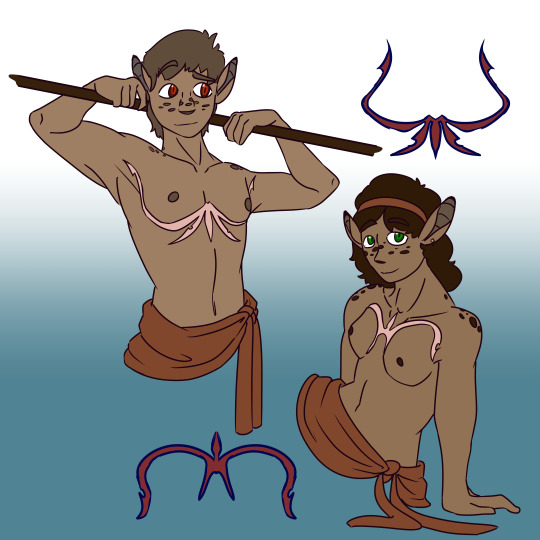

Happy pride y'all!
For today's Worldbuilding Wednesday, I present the ritualistic top scars of the United Islands!
So, within this work, the main POV character is a trans man, and part of the discussion this anthropologist writes about is how gender is expressed in the cultures he encounters, how it's different from his own, and how he's treated as a result.
For his own culture, the United Islands, they have a very open view in terms of gender expression. The primary religion has their god switch from male to female and back several times throughout the year, so seeing a person do the same isn't really a scandalous thing, it's actually partially considered a holy act, and a priest is requested to supervise the procedure, from social to medical transitioning.
So, if the person chooses, they can have certain gender affirming surgeries, and the scars are left in a very particular shape, depending on their specific transition.
The second image includes some newer/less traditional markings, which tend to be used by non binary or genderfluid folk.
Also:
Trans rights are human rights. Trans women are women. Trans men are men.
#worldbuilding wednesday#ask blog#send me asks#worldbuilding#ask box open#fantasy worldbuilding#my art#digital art#trans pride#non binary#non binary pride#genderfluid#genderfluid pride
3 notes
·
View notes
Text
I love lore and worldbuilding too!!! If you wanna know more about my big worldbuilding project, send me an ask! I'd be happy to share!
psa: I love lore and worldbuilding. I love lore and worldbuilding. I LOVE LORE AND WORLDBUILDING. I am absolutely gay for lore and worldbuilding, any time I see it on my dash or in my DMs I'm immediately just -heavy breathing-
I just think ya'll are so fucking NIFTY with your ideas and concepts and how you use them, it's exciting and worth celebrating !! creativity is hard sometimes and yet people come up with all sorts of things and it's always amazing and unique and I fucking LOVE it please never stop writing lore and worldbuilding folks
so like. if you have lore or worldbuilding, if you want to talk about your lore or worldbuilding, if you need to soundboard some lore or worldbuilding... I'm here for it. I will always be over here just -chin hands- tell me about your lore ! I wanna know all about it. I want to learn. lore and worldbuilding is the key to my heart.

4 notes
·
View notes
Text

Pride month, part 2! Now with the main couple from my worldbuilding project, Matacare and Masha, in their later years, happily growing old together.
Matacare is a scholar, anthropologist, and teacher who spent most of his adult life anywhere but his homeland to learn as much as he could. He also happens to be a pansexual trans man, who gave birth to his two daughters. Very kind, very curious, and a very loving husband and father.
Masha is Mata's friend turned lover turned husband over the course of said travels, initially tagging along to make sure Mata didn't get himself killed, but sticking around out of love and devotion for the whole journey. He commands a fleet of trading ships, although most of his sailing days are behind him to stick around home. He's bisexual, and pours every ounce of devotion he has into his family.
Also, if I have not made it obvious before, terfs can fuck right off. You're not welcome here. I will block if you start shit. For the rest of you, happy pride, and I'll be back with more characters next week!
--------------------------
Hey. Psssssst.
If you like these two, I opened an askblog for them recently. Check it out here and send an ask! Please! Okay, thank you.
3 notes
·
View notes
Text



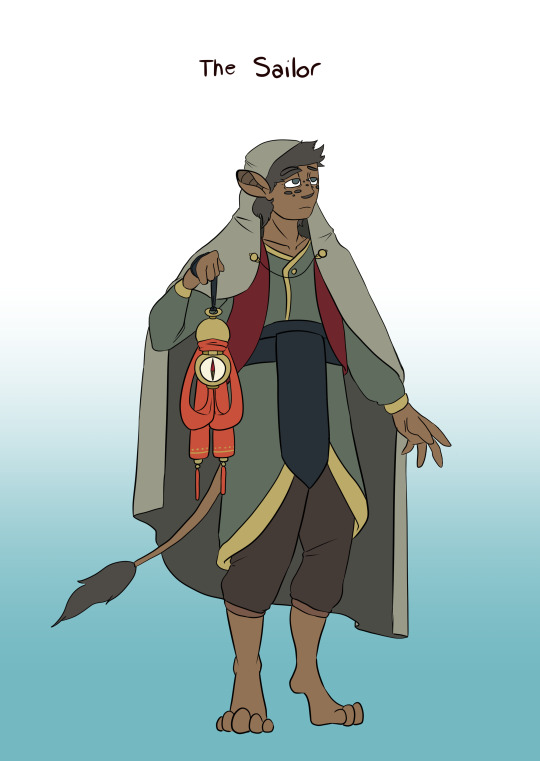

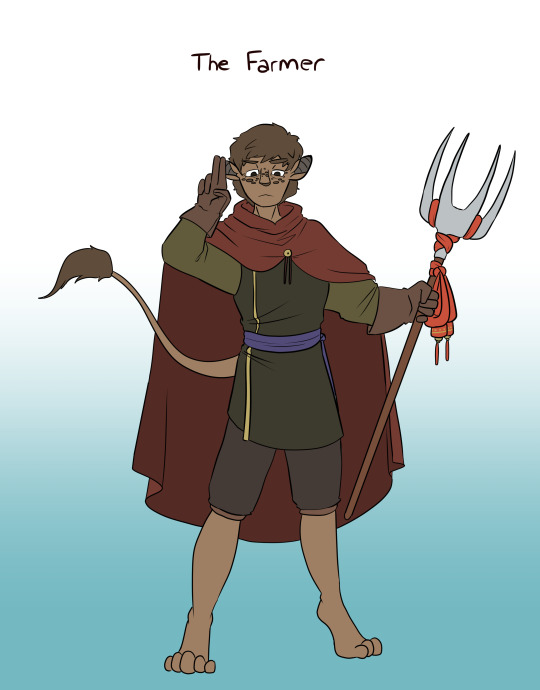


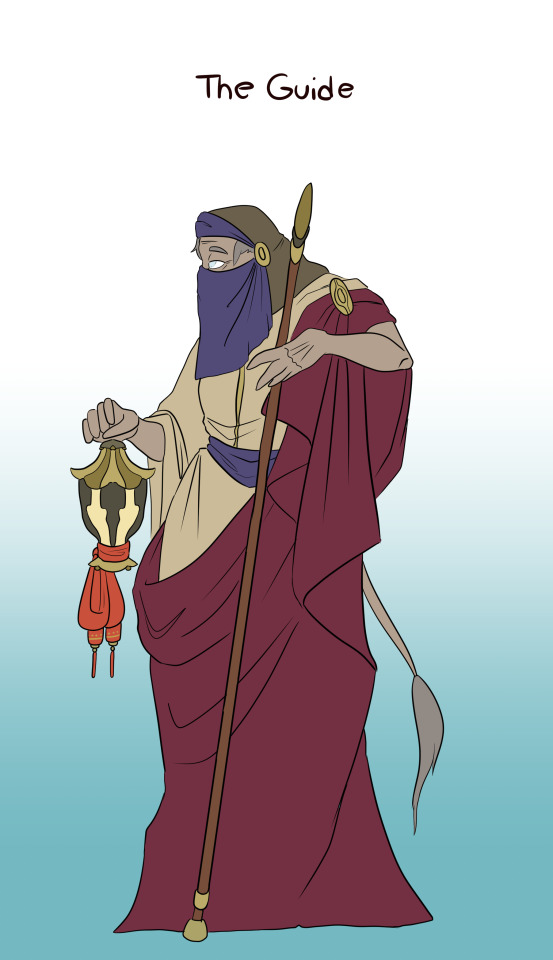
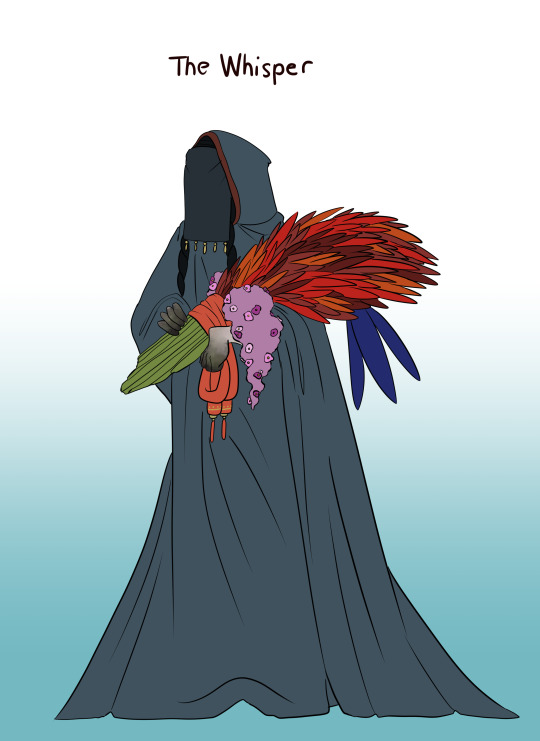

Behold, the primary religion of the United Islands! Lore under the cut!
Lore:
Behold, the great Ten Faced God! Or the Pantheon of Ten, if you subscribe to that belief.
Because, as is with history, the nature of the divine is a contentious subject in the United Islands. There are three main camps of thought:
The Ten Faced God asserts that there is one god, and that god changes forms throughout the year. They are one entity, although each form is not the same as each other. This is the newest interpretation, the currently dominant school of thought, and is practiced in most urban areas of the mainland and on the larger islands.
The Pantheon of Ten asserts that there are 10 different gods, with their own domains, who rise and fall in power throughout the year. They have relationships and a family tree (comment if you want to know more). This is the older of the two more common forms, and is practiced on the smaller islands to the south, and in some rural sections of the mainland.
The 10 Realms asserts that the gods are not entities at all, but a collection of spirits that serve under one of 10 divine domains people thing of as gods. This is the oldest form of the religion, only practiced anymore way out in the desert and in remote mountain villages, in small cults dedicated to specific spirits.
What all of these schools of thoughts agree on are the names and orders of the gods and their domains. In order there is:
The Shepherd: Also known as the Maiden, Queen, or Mother, the Shepherd is the goddess of fertility, animals, spring, and the soul. She is also known as the divine symbol of womanhood, motherhood, and children. She represents the love shared between a parent and child, and will strike down those who would bring harm to children. In the polytheistic model, she is the queen of the pantheon. Her divine symbol is the Shepherd's Crook.
The Dancer: Also known as the Paramour, Drunkard, or Trickster, the Dancer is the god of the arts, sex, emotion, games, and celebration. He is also the divine symbol of mischief, romance, creativity, and tricksters. He represents the fiery, passionate love in young relationships, and protects and tends to love wherever it may grow. His divine symbol is a basket of party favors, including wine, grapes, and fruit.
The Guardian: Also known as the Soldier, Sculpture, and Watchman, the Guardian is the goddess of war, the body, fire, and summer. She is also known as the divine symbol of strength, protection, and the land itself. She represents the love between a person and their country, and literally shaped the land to protect the people, according to mythology. Her divine symbol is her spear.
The Sailor: Also known as the Fisherman, Captain, or Storm, the Sailor is the god of the oceans, the weather, instincts, and fish. He is also known as the divine symbol of determination, the tides and currents, and the unpredictability of the world. He represents the love between a person and their craft, and will bless those in need of the drive to finish the job. His divine symbol is a compass.
The Merchant: Also known as the Gambler, Craftsman, or Surf (very controversial), the Merchant is the goddess of wealth, trade, luck, and commerce. She is also known as the divine symbol of fortune (both good and bad), workers, the artisans. She represents a love in the sense of aesthetic appreciation or infatuation and tends to follow flights of fancy whenever it strikes her. Her divine symbol is a coin purse.
The Farmer: Also known as the Father, King, or Reaper, the Farmer is the god of fertility, agriculture, work ethic, and autumn. He is also known as the divine symbol of manhood, fatherhood, and marriage. He represents the older, mature love between long time committed partners, and will strike down those who would threaten their own family, particularly their partner. In the polytheistic model, he is the king of the pantheon. His symbol is a pitchfork.
The Judge: Also known as the Debt Collector, Politician, or Balancer, the Judge is the goddess of justice, conscience, shelter, and leadership. She is the divine symbol of politicians, the courts, leaders, and even criminals. She represents the love between a person and society, and watches those who may abuse such society, both the criminals and ones who prosecute them. Her divine symbol is a balancing scale.
The Traveler: Also known as the Wanderer, Stranger, or Vagabond, the Traveler is the god of roads, the mind, winter, and knowledge. He is the divine symbol of curiosity, scholars, travelers, and storytellers. He represents the love between a person and the world around them, and is known to compel people to wander away from home. His divine symbol is his walking cane.
The Guide: Also known as the Weeper, Ferryman, or Mourner, the Guide is the god of time, rivers, the moons, and medicine. They are the divine symbol of the aging, frost, and endings. They represent the brotherhood love between two friends, ones who would die for each other. They are the divine protector of the sick, dying, and those who mourn for them. They are described as neither man nor woman, but something in-between. Their divine symbol is their lantern.
The Whisper: Also known as the Mist, Silent, or Shrouded, the Whisper is the god of death, sleep, and cycles. They are the divine symbol of mist, dreams, and the dead, as well as the end of the year. They represent the compassionate love one must have for themselves, and only is said to act upon the world during the last two days (or three if it's a leap year) of the year, collecting those who have died and take them back to the garden from which they were made. They are described as completely genderless. Their divine symbol is the death bouquet.
#ask blog#ask box open#send me asks#worldbuilding#fantasy worldbuilding#digital art#my art#worldbuilding ask blog#worldbuilding religion#nonbinary character#agender character
7 notes
·
View notes
Text

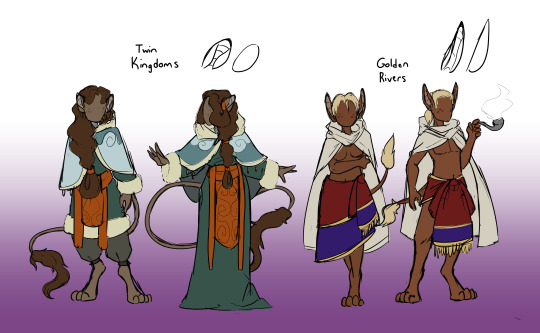
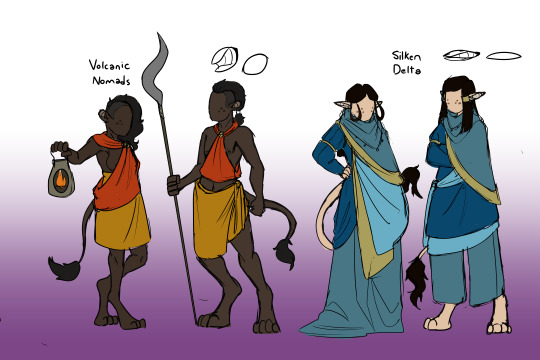


Posted this on the main blog, but now that the worldbuilding project has its own blog, it belongs here too!
The ethnic groups and mid-level fashion of Matacare’s journey, in the order that he visited them.
More notes under the cut!
The species are mostly humanoid, with the addition of tails, more animalistic ears that are more articulate, digitigrade feet, and they loose pigment in the winter (although how extreme this pigment loss is has been affected by the local climate). Also, they most often give birth to twins, their hair is really slow to grow, and their tails are just a step below prehensile (fully articulate, but not strong enough to hold onto anything). Matacare himself is from the United Islands, and he travels in the order presented. Here’s a quick rundown of the cultures presented.
United Islands: A united nation consisting of nine islands and the peninsula attached to the continent. They live in a mostly Mediterranean climate on the Southern Hemisphere, however the southern most islands dip into more frigid temperatures. They’re a democracy in which each member state has their own representatives. They’re a largely agricultural, mercantile, and naval power, but have become mostly stagnant in terms of reaching outward.
Jungle of Flowers: A matriarchal monarchy on the eastern coast of the western continent. They live in a humid, tropical climate with jungles and swamps. They are ruled by a family of queens, in which a select set of sisters mothered by the previous queens rule together. They’re agricultural with their main exports of fruits, sugar, and rare woods, but are also skilled hunters and sell leathers and hides. They conflict a lot with smaller kingdoms along their main river further inland.
Twin Kingdoms: A pair of united kingdoms situated on an island to the western north. They live in a dry, frigid climate similar to Iceland, and live mostly in the colder weather. They were once two kingdoms, but are now united as one, with their king (can be either male or female, but use the term king generically) selected by a contest of survival and skill. They’re mostly herdsmen and fishermen, selling high quality wool, aquatic mammal skins, and fish. While the two kingdoms are technically united, there is still bad blood from previous conflicts.
Golden River: A group of many smaller, loosely connected kingdoms who all answer to a unifying religious ruler. They live in a desert, centered around a riverplain that empties into the ocean, on the northern coast of the eastern continent. Each kingdom rules independently of each other, but the divine leader can make commands to all of them. The smaller kingdoms constantly vie for more power against each other by trying to have one of their own as the next divine ruler. They trade in precious and practical metals like gold, iron, and copper.
Volcanic Nomads: A loosely connected kingdom of tribes lead by chiefs who can be called on and commanded by a king. They live on a large island off the north eastern coast of the eastern continent. The tribes meet every few years to elect a new king from the chiefs, who can speak for them all when engaging with other nations. The tribes often fight with each other for pastoral land and animals, but they’ve recently united in order to expand to the mainland. They trade in meat, beasts of burden, and animal fat oils used for lights and certain new technologies.
Silken Delta: A coalition of states scattered across a peninsula splintered by a massive river delta system. They live in a tropical and Mediterranean climate with scattered marshland. Each state sends a member to a unified council, with those council members serving as the local heads of state for their origin state. While they don’t conflict with the United Islands directly, they do see themselves as economic rivals to them. They trade in fine fabrics for clothing, beans and other grains, and spices/herbs.
1 note
·
View note
Text

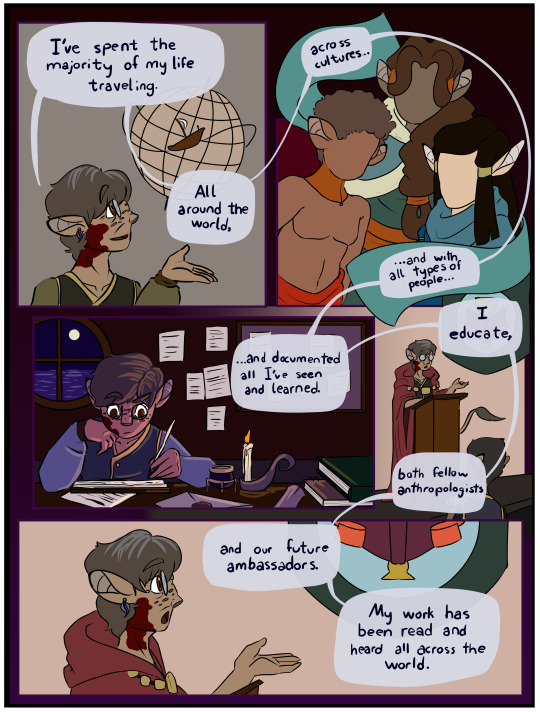


~Matacare is now available for questions~
Author Notes under the cut!
Welcome to Traveling and Wandering, an askblog dedicated to a worldbuilding project I've been cooking up for a few years now. Meet Matacare, an anthropologist scholar who's been all over the world, lived in 6 countries, and traveled to dozens more, on all corners of the globe. He's lived a long life, seen a lot of things, and is eager to share it with anyone who's curious. I hope you all like him!
3 notes
·
View notes
Text
Ask Blog Masterpost:
Ask Box Status: OPEN!
Characters available: Matakare
First Post Here!
Rules under the cut!
RULES:
Keep it focused to worldbuilding or character asks please! This is actually pretty open to interpretation, so don't be scared to ask things! You can ask questions about the places the characters have visited, stuff about their life, their personalities, or the world around them.
Keep any NSFW asks phrased PG-13 at most! I'm not opposed to answer questions regarding sexuality and all that entails, but I'm not looking for this blog to be 18+. So, no explicit descriptions, or I'll just delete your ask. I will not answer any questions regarding incest or pedophilia, so don't even bother.
Don't spam please! If I don't get to your ask right away, be patient. There are a number of reasons I might not get to it, like if I have other asks in the queue ahead of you, it's off topic, or Tumblr might've eaten it. If it's been a while, and I still haven't gotten to it, shoot me an ask to remind me. But, if you keep spamming a question, I'll probably be way less likely to touch it.
Magic anons are off by default! Magic anons will not be acknowledged most of the time. I might host events where magic anons are allowed, but I will make a post about it! So don't jump the gun please.
I have the right to ignore asks, block users, or change rules as I see fit! Don't be the reason I have to add more rules. Keep it polite, keep it on topic, and keep it kind.
2 notes
·
View notes
Text




~Matakare is now available for questions~
Author Notes under the cut!
Welcome to Traveling and Wandering, an askblog dedicated to a worldbuilding project I've been cooking up for a few years now. Meet Matacare, an anthropologist scholar who's been all over the world, lived in 6 countries, and traveled to dozens more, on all corners of the globe. He's lived a long life, seen a lot of things, and is eager to share it with anyone who's curious. I hope you all like him!
#ask blog#send me asks#worldbuilding#worldbuilding ask blog#fantasy#fantasy art#fantasy worldbuilding#my art#digital art#comic#ask blog introduction#ask box open#rp blog
3 notes
·
View notes
